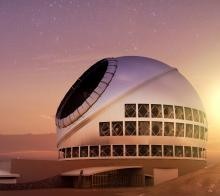TMT Petitioners File Hawai‘i Supreme Court Appeal
Mauna Kea Anania Hou; KAHEA: The Hawaiian Environmental Alliance; the Flores-Case ‘Ohana; and individual petitioners filed an online appeal late Nov. 6, 2016, with the Hawai‘i Supreme Court. The individual petitioners include Kealoha Pisciotta, Clarence Kukauakahi Ching, Deborah Ward and Paul Neves.
The appeal was filed over alleged due process rights violations during the state Board of Land and Natural Resources Contested Case Hearing on the Thirty Meter Telescope project proposed by the University of Hawai‘i at Hilo atop Mauna Kea, Hawai‘i Island’s largest volcano, .
During the BLNR contested case hearing on Monday, Oct. 31, the hearing officer, retired Judge Riki May Amano, ruled that the time for cross-examination of each witness would be limited to 30 minutes.
Pisciotta, a petitioner representing Mauna Kea Anaina Hou and herself at the hearing, explained that the appeal filed with the state’s highest Hawai‘i court comes down to what she classified as fundamental issues, and specifically, violations of due process.
Due process is defined as the official and proper way of doing things in a legal case: the rule that a legal case must be conducted in a way that protects the rights of all the people involved.
According to a court record, the appellants argue that Judge Amano violated their due process rights with her oral 30-minute cross-examination time limit.
Pisciotta said that due to the judge making oral rulings, those who object have been prohibited from making a motion in response to such rulings.
Records filed last week show that in addition to the due-process violation, the appellants argue that Judge Amano has a conflict of interest in hearing this case and has shown bias in her rulings; therefore, she should be disqualified as the hearing officer.
Pisciotta further explained that MKAH believes, “When there is a hearing officer who cannot rule without bias, you have to challenge that.”
She also pointed out the importance of equal treatment of each party and following the laws that apply to this case, because otherwise, everyone involved risks the possibility of the case being ruled as invalid—the entire time and work put into the ongoing hearing would be a waste.
“It’s the fairest thing to do right now,” explained Pisciotta.
In 2015, Act 48 was passed. This law allows contested case appeals to go directly to the state Supreme Court.
A contested case hearing was requested with respect to the 2011 TMT decision by the BLNR to issue a permit to build the $1.4 billion next-generation telescope near the summit of Mauna Kea.
The Hawai‘i Supreme Court ruled the permit invalid until a contested case hearing could be held to evaluate a petition by a group challenging the project’s approval.
Proponents of the TMT project hope the construction of the observatory will resume no later than April 2018, however, the TMT International Observatory announced an alternate location in the Canary Islands if the project cannot be built on Hawai‘i Island. The Mauna Kea location remains the project’s first choice.
The outcome of the contested case hearing will decide where the observatory is built.
The BLNR contested case hearing will resume Tuesday, Nov. 15, in the Willie K. Room at The Grand Naniloa Hotel Hilo on Banyan Drive on the island of Hawai‘i, with University of Hawai‘i at Hilo witnesses Judge Walter Heen and Jessie Eiben.
Heen will testify about the history of UH management of Mauna Kea. Eiben will testify about the biological impact of the TMT project, specifically, on the endemic wēkiu bug.
UH-Hilo witness Robert McLaren of the Institute for Astronomy and UH witness James T. Hayes will return to the stand on Wednesday, Nov. 16.
The BLNR contested case hearing on the TMT project is also scheduled for Nov. 18, and Dec, 1, 2, 5, 6, 8, 9, 12, 13, 16, 19 and 20.
Download the entire UH-Hilo witness list.
Big Island Now will provide coverage of this week’s TMT hearing.
RELATED LINK
Judge Puts Time Limit on TMT Cross-Examinations
TMT Hearing: Native Hawaiian Navigator Testifies









